We’re proud to present the long-awaited, world's first DirectX 11 graphics card – Radeon HD 5870. Better known as Cypress, the Radeon HD 5870 is currently the fastest single-GPU card, and it instantly dethroned its single-GPU competition. Our today’s sample is courtesy of XFX, and the card’s full name is XFX ATI Radeon HD 5870 1GB.
The HD 5870 packs a whole lotta speed, but the card brings many other benefits such as DX11 and the accompanying technologies – hardware tessellation, shader 5.0 extensions, multi-threading, DirectCompute and OpenCL which for ATI opens the doors of stream computing, etc. If you’ve been following the card’s announcement then the Eyefinity technology probably caught your eye, and this technology (depending on the partners’ choice of outs) allows for up to six monitors on one card. If you own a flight school or simply are planning to treat yourself to some serious multi-display goodness, you can buy yourself four Cypress cards for up to 24 monitors that will allow for a so far consumer-unprecedented multi-display configuration.
So, Cypress is a high-end DirectX 11 single-GPU graphics card, but as we've come to expect from graphics companies, dual-GPU versions of the HD 5870 codenamed Hemlock or HD 5870 X2 will follow. Although Radeon HD 5850 launched as well, more samples of this slightly slower DX11 card will be available in about one week.All the following DX11 card are in Evergreen family of products, and the codenames are as follows: Cedar, Redwood, Juniper, Cypress and Hemlock (ordered from the bottom to the top).
ATI’s HD 5870 1GB version comes with GDDR5 memory, DVI, HDMI and DisplayPort, and is priced at around $399 or €320 (VAT incl.) in EU. The 2GB version of Cypress and Eyefinity version will end up pricier, but they’re definitely good deals compared to Nvidia’s GT200 or Radeon 48x0 cards.
Juniper cards are expected in this quarter and should be priced below $199 whereas Cedar and Redwood, which should be out by the end of 2009, should bring DX11 support to the sub-$100 segment. The only problem for AMD is the fact that there are no DirectX 11 games on the market currently, which would’ve boosted Evergreen sales significantly. Of course, you’ll find many musle-hungry DX9, DX10 and DX10.1 titles that can put Cypress to good use, but investing a reasonable amount of cash for a bright DX11 future isn’t a bad deal at all.
A glance at the specifications reveals that the new graphics chip is almost twice the chip its predecessor was. The shaders got a boost from 800 (HD4890) to 1600 (HD 5870) thanks to a significant number of added transistors. The Cypress GPU features complex architecture with 2.15 billion transistors, whereas the HD 4890 has 959 million. Despite the improvements, the die on the new card measures 338mm, which isn't much larger than the 282mm old one. In order to cram so many transistors in such small space AMD transitioned from 55nm to 40nm. Let us remind you that AMD was first to deliver 40nm products by announcing the HD 4870 from the HD 4700 series.
The HD 5870 features 32 ROP units, double the amount found on the HD 4870. Texture units have been doubled as well and the HD 5870 features 80, and the computing power jumped from 1.2 TFLOPs to 2.72 TFLOPs as well.
AMD however didn’t only focus its efforts towards doubling the performance, but paid attention to power consumption as well, so the new card doesn’t consume much more than its predecessor. The HD 5870’s maximum consumption is 188W, whereas the HD 4870 consumed up to 160W. AMD finally addressed the idle consumption, and the company claims that HD 5870 requires only 27W.
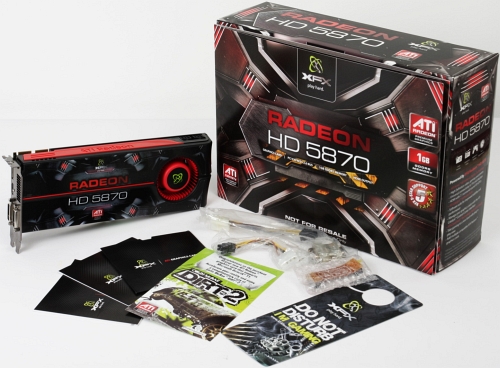
XFX Radeon HD 5870 comes in a large but nicely designed box, with a velcro-attached poster which acts as a lid at the same time. When you remove and unfold the poster, it looks as though you're looking at three monitors connected to the XFX HD 5870. This is a way to promote Eyefinity technology, i.e. support for more than two monitors on your graphics card. This technology allow for scenarios like using three 30'' monitors, where the graphics card can combine their resolutions and distribute the 7680x3200 picture across three monitors.
The box contains two 6-pin cables, DVI-to-VGA adapter, Crossfire connector, driver CD, the Dirt 2 coupon and XFX's neat "Don't Disturb I'm Gaming" doorsign.
If you happen to buy a 5870 Eyefinity card with 6 video outs, you can expect 1920x1080 resolution per monitor. It would’ve really been great if we had three monitors at our disposal, as we could’ve put the XFX-provided Colin McRae Dirt 2 coupon to some good multi-display use.
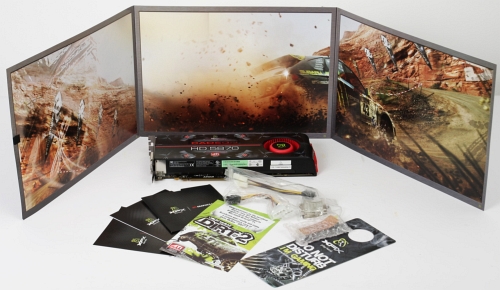
As you can see from the picture, the cooler stretches the entire length of the HD 5870 graphics card. The card looks big and powerful, just like it’s supposed to be, and it’s 1cm longer than the 27cm long dual-GPU HD 4870 X2 card.
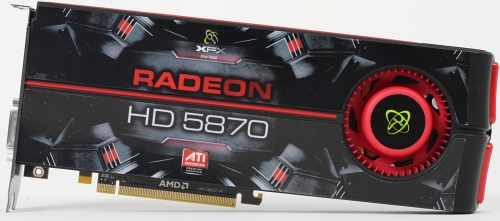
The reference ATI HD 5870 card comes with a black matter cooler with a red line in the middle, and XFX put their sticker which fit nicely with the rest of the card.
We must admit we were pretty concerned about the XFX HD 5870 cooler’s “noise potential”, as this large cooler features pretty small air outlets. The I/O panel features so many outs that only a fraction of space was left for ventilation. This is why a significant amount of hot air is left inside the case. The following picture shows a nicely engraved ATI Radeon logo on the upper side of the card.

On the rear of the card you’ll find a metal plate for which we can’t say with certainty whether it helps in cooling the card, but it shields the PCB from potential damage and sure looks good. The following picture shows the graphics core. The Crossfire connectors kept their standard position and we already mentioned that 4 Cypress Eyefinity cards will allow for an impressive number of 24 monitors.
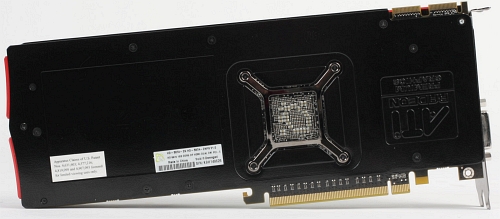
You won’t find memory modules underneath the plate as all 8 modules are placed on the GPU side of the PCB. The cooling is firmly fixed in its place with screws going through the PCB and into the metal plate.

The cooler stretches the entire length of the PCB and it's mostly made of copper. As you can see from the thermal paste prints, it leans on the memory and many other power components.

The combination of the heavy copper base, heatpipe technology and a large dissipation surface area on the aluminum fins helps the cooler to keep the card at about 80°C during operations. In extreme FurMark scenarios the card can hit up to 86°C, but while gaming it never exceeds 80°C.
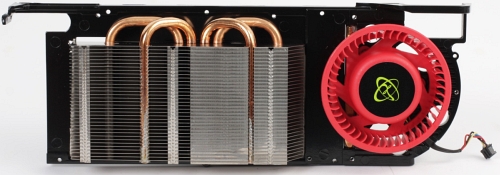
Note however that we used the large CoolerMaster ATCS 840 case with a great airflow, but smaller and more cramped cases might result in higher temperatures. Idle temperatures were around 39°C. The fan does a good job and while it's not too loud, we'd still have liked if it could be quieter. Note that idle operation results in pretty low noise levels.
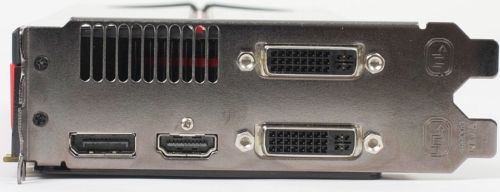
The I/O panel features two dual-link DVI outs, one HDMI and one DisplayPort out. The card allows for three monitors at the same time.
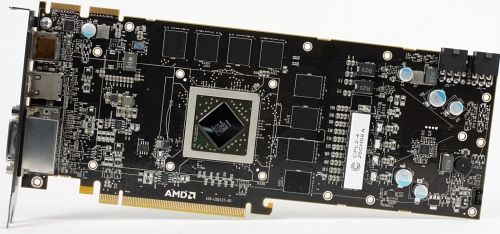
AMD did a good job on the power management circuitry and used two Voltera VT1165 MF Voltage controllers which can be controlled from software. The card draws power from two 6-pin power connectors.
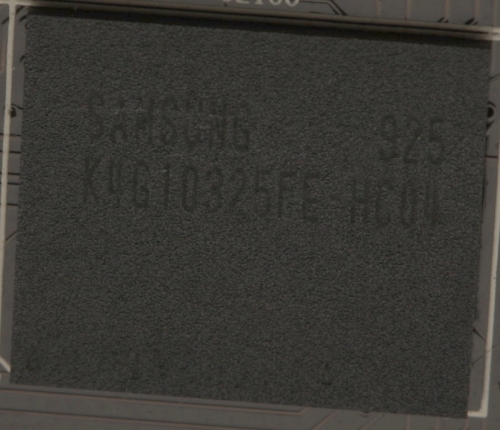
The card uses new Samsung’s K4G10325FE-HC04 rated at 1250MHz (5000MHz GDDR5 effectively).
AMD's new Cypress GPU has 2154 millin transistors and is produced on a 40nm prorcess,
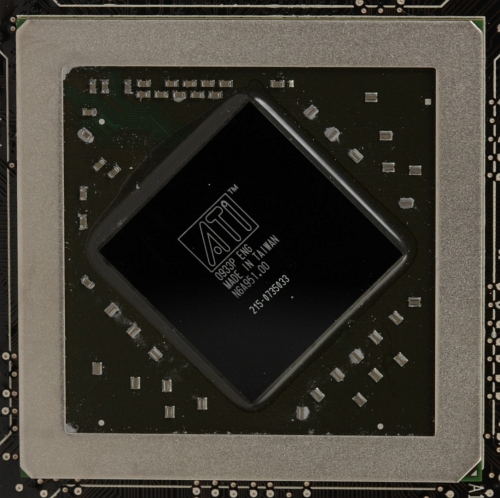
Futuremark tests show that the currently fastest single-GPU Radeon HD 5870 card packs enough muscle to beat the dual GPU HD 4870 X2. The HD 5870 has up to 8% better result, whereas Nvidia’s best single-GPU card, the GTX 285 loses in Futuremark by as much as 30%.


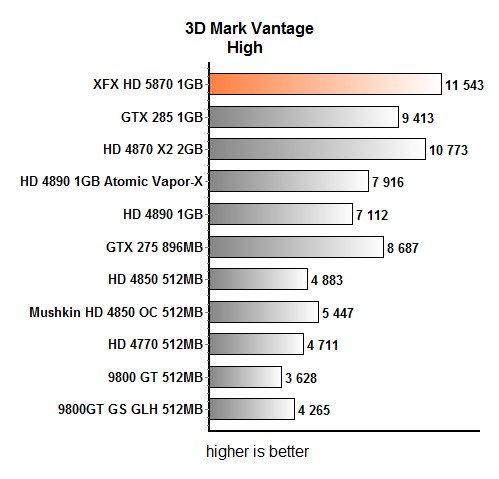
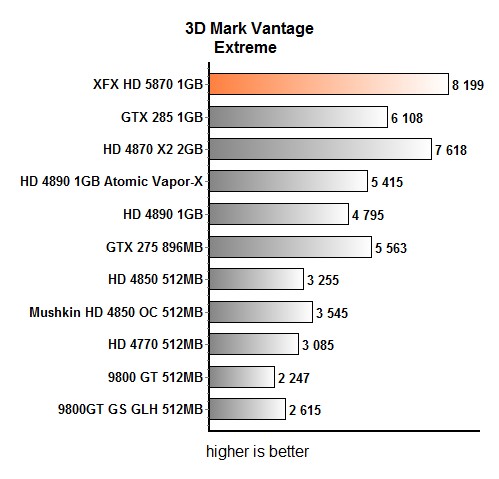
Games
Far Cry 2
FarCry 2 sees the HD 5870 repeating its success in Futuremark by leaving the GTX 285 in the dust by as much as 30%. The lowest performance difference between these two cards was 12%.
The performance gap between the HD 5870 and HD 4870 X2 varies. The HD 5870 loses by 14% 1920x1200, but seriously shines at 2560x1600 with antialiasing on, as it beats the HD 4870 X2 by 9%.






HAWX
Thanks to DirectX 10.1 support, HAWX really likes AMD Radeon cards. With DX10.1 support enabled, the GTX 285 suffers a tough defeat. The HD 4870 X2 ends up about 23% better than the HD 5870.
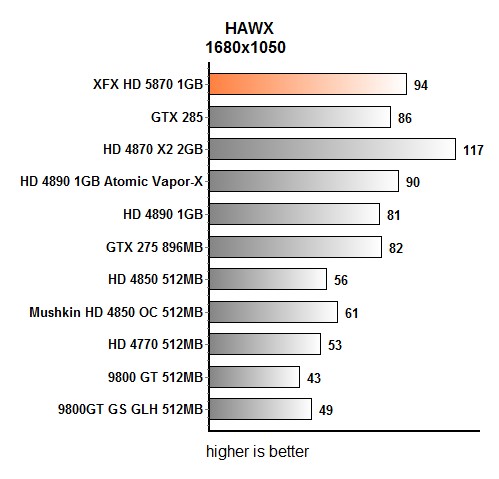
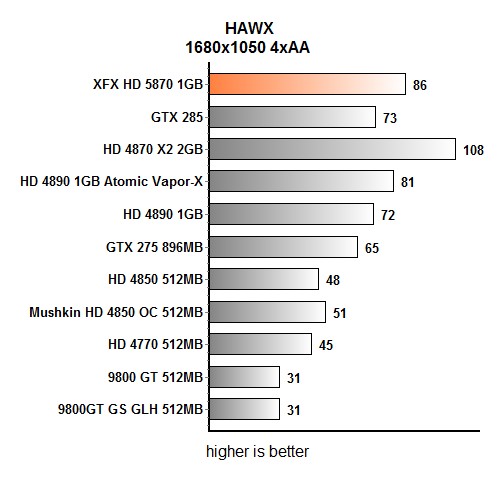
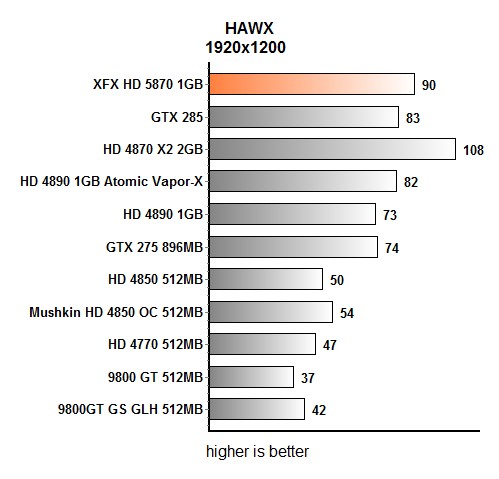
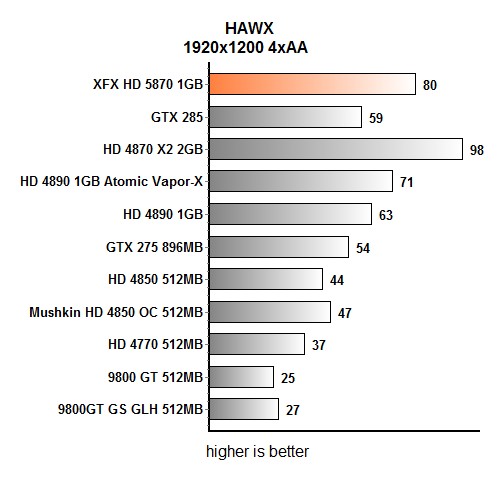
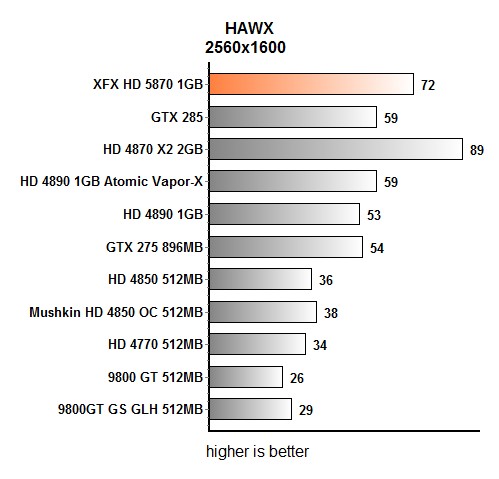
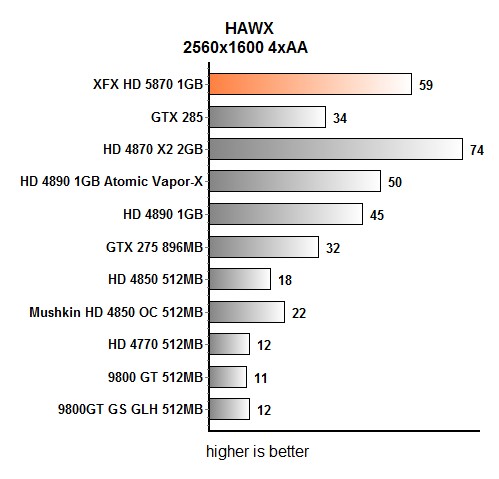
Games
Left 4 Dead
Thanks to DirectX 10.1 support, HAWX really likes AMD Radeon cards. With DX10.1 support enabled, the GTX 285 suffers a tough defeat. The HD 4870 X2 ends up about 23% better than the HD 5870.






World in Conflict
World in Conflict seems to like the XFX HD 5870 at most resolutions, leaving Radeon HD 4870 X2 behind by up to 8%. The Geforce GTX 285 scores from 6% to 34% lower than XFX HD 5870.






Power Consumption, Overclocking, Noise
The XFX HD 5870 temperatures went from 39°C in idle mode to 80°C during our gaming sessions. The card has a pretty small air outlet next to the display connector, whereas the other outlet is next to the Crossfire connectors. If your case features has air outlets on the panel next to the graphics card, then hot air will entirely exit your case. If on the other hand, you own a smaller and relatively crammed case then you’re in a pickle, as the hot air will increase the overall temperatures of your components, including the graphics card of course.
We managed to overclock the GPU to 890MHz (a 5% overclock) and the memory to 1295MHz (an 8% overclock). Overclocking will go much smoother if you increase the card’s voltages, but we’ll leave that to overclocking enthusiast. Furthermore, we’ve heard that some partners already provide software tools for GPU voltage management.
Idle consumption on the HD 5870 is great. The core downclocks to 157MHz and the memory to 300MHz. Minimum consumption is just over 20W whereas maximum consumption goes up to 188W. Our entire rig consumed up to 335W, very similar to the much slower HD 4890.
Conclusion
The new AMD Radeon HD 5870 will definitely be remembered for being the first DirectX 11 card as well as the fastest single-GPU card, and we must admit it performs excellent. As a matter of fact, occasional beating the dual-GPU Radeon HD 4870 X2 card is enough proof of what this card is capable of, and the improvement from the previous generation is obvious. Compared to the previous generation, AMD doubled the count of pretty much everything - shaders are now up to 1600, the ROP and texture units as well and the computing power is now well over 2 TFLOPs. And let's not forget the fact that if you're looking for an uncompromisingly fast DX11 card - this is currently the only choice you have.
Thankfully, AMD addressed the consumption issues with the previous generation, and the card consumes slightly over 20W in idle now. The maximum consumption of 188W isn't half bad either for a card of this calibre, but note that it's a still bit higher than on the previous generation.
XFX HD 5870 card comes with large dual slot cooling and you should know that it's 28cm long. The reference cooler comes with XFX's sticker on it, but the cooler itself does a good job without making excessive noise. With the card you'll recieve a coupon for Dirt 2, which should as we hear introduce some DX11 "tricks".
As you have seen, it's clearly faster than the Geforce GTX 285, and while some tests see it beat the dual-GPU ATI 4870 X2 card, the HD 5870's performance level is still below the HD 4870 X2's or GTX 295's. So, this card has what it takes to outrun the competition, as well as DirectX 11 up its sleeve - quite important for those who want an upgrade that will last a while.
When it comes to pricing, early birds will naturally have to pay some extra bucks and you can find it listed in etail stores at an average of €330 or $380. Some might decide to wait a few months for the price drops but if you don't mind the extra couple of bucks, we'd seriously advise you to grab one as soon as it's available, as the free Dirt 2 game makes it even more appealing.
The price is a tad steep for our taste ,but the upcoming Radeon 5850 is set to fix that. On the other hand, despite the fact that ATI is the first to come out with a DirectX 11 card, know that Nvidia isn't asleep either.
If you're looking for an upgrade, a future-proof one, then this DirectX 11 and currently the fastest single-GPU card on the market is the right choice. If you can't stand the wait, go for it and you definitely won't regret it.

